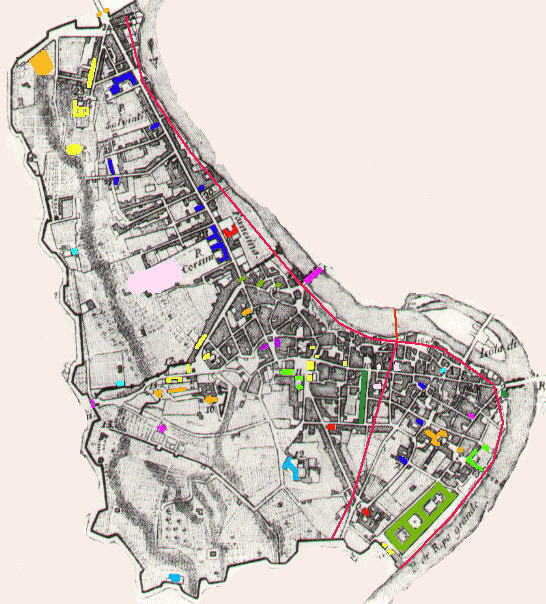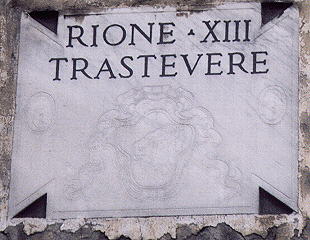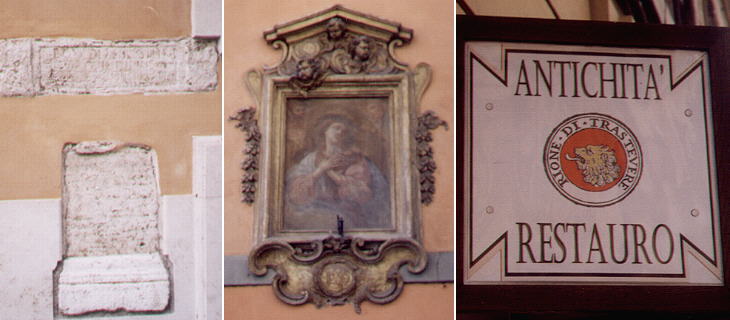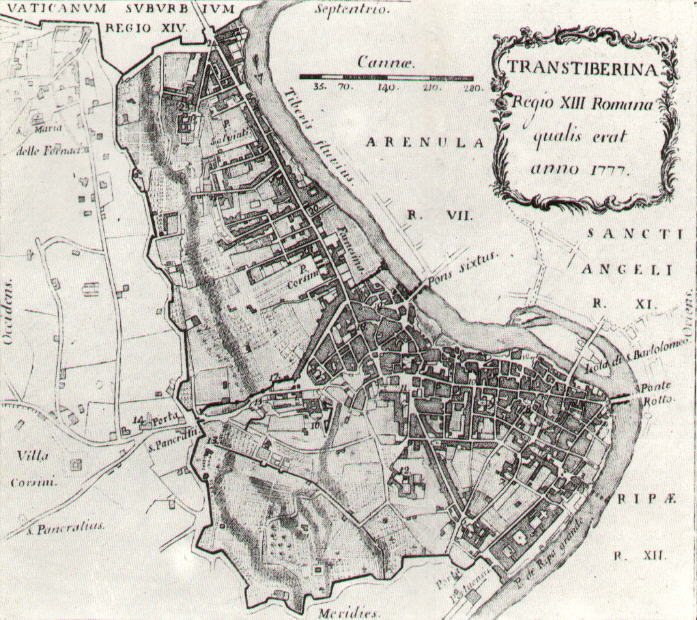  Rione XIII Trastevere
Trastevere is a corruption of trans Tiberim (beyond the Tiber). Ancient Rome was founded on seven hills located on the left bank of
the Tiber. The right bank (trans Tiberim) belonged to the Etruscans and most likely to the town of Veius (today Isola Farnese). A famous episode of early
Roman history makes reference to the defence of Rome which took place on the timber bridge which crossed the river (Ponte Sublicio). Only after the defeat of Veius and
the expansion of the Roman rule to most of Central Italy did the right bank of the river become an
area of stable Roman settlements. However only in 275 A.D. Trastevere was included by the emperor Aureliamus
in the pomerium
(the city border) of Rome and it was protected by walls. In the XVIIth century Urbanus VIII redesigned the borders of Trastevere by building
new walls which included in the rione most of the Janiculum hill.
The symbol of Rione Trastevere is a lion's head. Trastevere does not have imposing ruins of ancient Rome: at that time its inhabitants were mainly foreigners: ruins of a Syrian temple have been found in Villa Sciarra; traces of a sanctuary dedicated to the mysterious cult of Bona Dea have been found near S. Giovanni Battista dei Genovesi. The Roman walls are almost completely lost. In the XIXth century the excavation of Roman barracks near S. Grisogono showed that in the past the level of the ground near the river was some 20 ft lower than it is today. Medieval Trastevere can still be found in the streets near S. Benedetto in Piscinula. The main church of Trastevere, S. Maria in Trastevere has fine medieval mosaics. One of the jewels of the Renaissance can be found in Tempietto del Bramante in S. Pietro in Montorio. In the early XVIIth century Trastevere got once again an ample supply of water. Pope Paulus V reactivated an ancient Roman aqueduct. The fountain built to celebrate this achievement (Mostra dell'Acqua Paola) is the most imposing monument of Trastevere. Palazzo Corsini and its gardens are the most interesting XVIIIth century addition to the rione.
In today's Rome the sense of belonging to a certain rione has since long disappeared: less than 5% of today's inhabitants of Rome live in the 14 historical rioni, but Trastevere is no doubt an exception. Its inhabitants believe to be "Romani de' Roma", true Romans and many associations try to keep alive old traditions including a yearly fair. That's why many shops show the symbol of the rione.
Legend: 1) S. Benedetto in Piscinula 2) S. Salvatore a Ponte Rotto 3) Casino di Donna Olimpia 4) S. Cecilia 5) Ospizio di S. Michele a Ripa 6) S. Francesco a Ripa 7) S. Maria dell'Orto 8) S. Salvatore della Corte 9) S. Grisogono 10) S. Gallicano 11) S. Maria in Trastevere 12) SS. Cosmo e Damiano 13) Villa Spada 14) Porta S. Pancrazio 15) Acqua Paola 16) S. Pietro in Montorio 17) Bosco degli Arcadi 18) S. Maria della Scala 19) S. Giovanni della Malva 20) S. Giacomo alla Lungara 21) Regina Coeli 22) S. Maria della Visitazione 23) S. Onofrio 24) Porta S. Spirito 
Main monuments of Rione Trastevere The red lines in the map show the major changes which occurred after 1777: a) the long line along the river shows the redesign of the bank in the 1880s: this led to the loss of some churches in Via della Lungara, of most of Giardino Farnese and of S. Salvatore a Ponte Rotto; b) line across the river and into Trastevere: in 1887 a new bridge (Ponte Garibaldi) and a large avenue (today Viale Trastevere) created a new traffic axis which cut the rione into two parts. The different colours group the monuments which are shown in the same page (the list includes a few minor monuments omitted in the map). You can also have a very close look at it from the Janiculum: S. Spirito in Sassia, S. Giovanni dei Fiorentini, Carceri Nuove, S. Eligio degli Orefici, Palazzo Farnese, Ponte Sisto, la Renella, S. Sabina, S. Maria in Trastevere, S. Pietro in Montorio, Acqua Paola and S. Maria dei Sette Dolori. You may also attend the Procession of Madonna de Noantri.
 or to
The Coats of Arms of the Popes or
to My Home Page on Baroque Rome or to
My Home Page on Rome in the footsteps of an XVIIIth century traveller or to
The Coats of Arms of the Popes or
to My Home Page on Baroque Rome or to
My Home Page on Rome in the footsteps of an XVIIIth century traveller
|
All images © 1999 - 2004 by Roberto Piperno. Write to romapip@quipo.it


